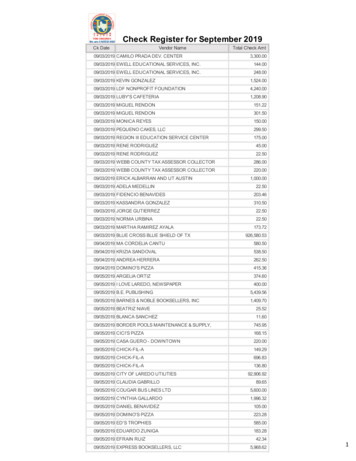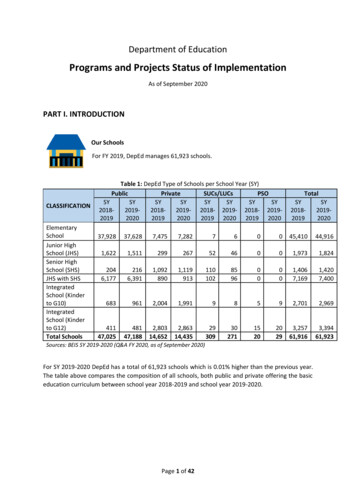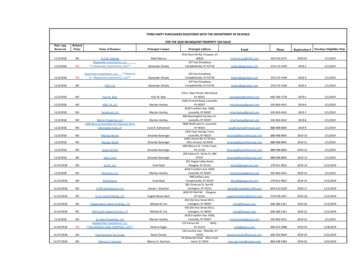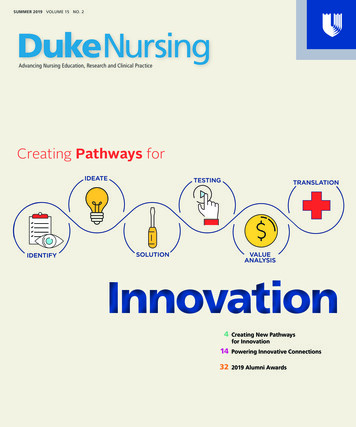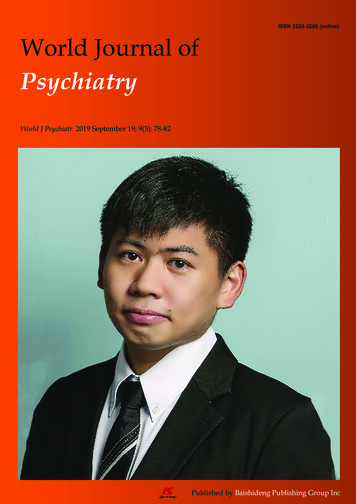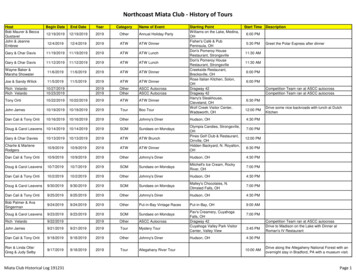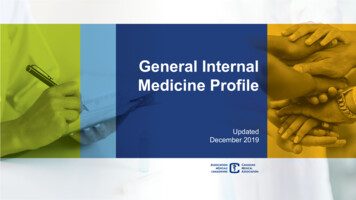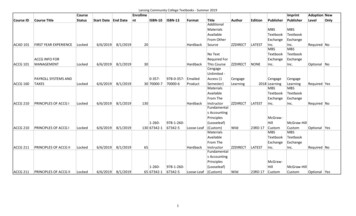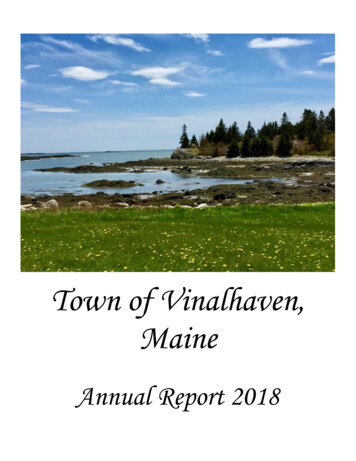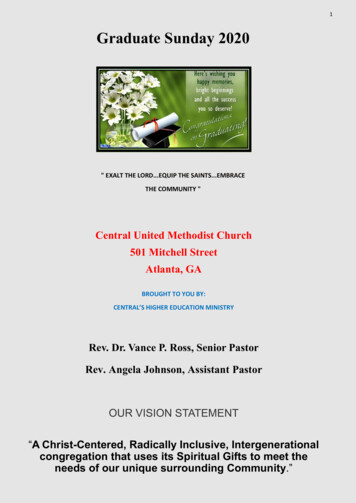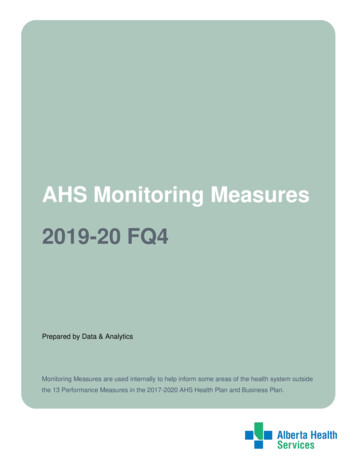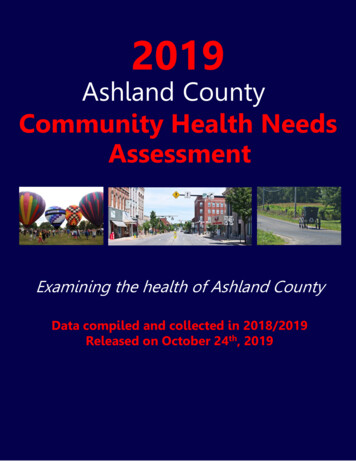
Transcription
2019Ashland CountyCommunity Health NeedsAssessmentExamining the health of Ashland CountyData compiled and collected in 2018/2019Released on October 24th, 2019
ForewordThe Ashland County Health Department, on behalf of the Ashland Community Health AssessmentCommittee is pleased to present this publication, the result of the 2019 health needs assessment ofadults and youth in Ashland County. The data was collected through surveys of health status and healthbehavior that were conducted by the Hospital Council of Northwest Ohio (HCNO). The survey results arereported along with health statistics and information gathered from the Ohio Department of Health andother relevant national, state and local data sources.This report provides a “snapshot” of where county residents currently stand in terms of their health andhealth behaviors. The data components of this comprehensive review can serve as strategic planningsources for organizations and individuals who are striving to make Ashland County a healthiercommunity. In this era of rising costs and shrinking revenues, it is imperative that we focus our limitedresources on those services and activities that will have the greatest positive impact on county residents’health. In that respect, the report’s information can influence the current course of action and supportnew areas of interest. An added value with this year’s report is the access to data from similar studies thathave been completed in more than 40 other Ohio counties; this information is available at www.hcno.org,and provides opportunities for comparison, sharing, and cross jurisdictional collaboration in planning.This report would not have been possible without the assistance of several community leaders andorganizations. We thank them for their support in making this health needs assessment a reality. TheAshland County Health Department would like to thank University Hospitals, Ashland County MentalHealth & Recovery Board, City of Ashland, and the Ashland County Commissioners for providingassistance with the financial supports as well as conveying their community-wide support on such aninvaluable project for the improved health and wellness of all Ashland County residents. We areespecially grateful to the Hospital Council of Northwest Ohio for providing professional expertise andguidance throughout the process, in developing and conducting surveys, collecting and analyzing data,and presenting information in a format that is useful and easy to comprehend. We encourage you to beopen to new ideas and collaborations as you use this report in considering the health needs of AshlandCounty residents. It takes all of us, working together, to guide Ashland County towards a healthier future.Sincerely,Sarah Goodwill Humphrey, MPH, CPH, RSHealth CommissionerAshland County Health DepartmentFOREWORD 1
AcknowledgementsThis report has been funded by:Ashland County Health DepartmentUniversity HospitalsAshland County Mental Health & Recovery BoardAshland County CommissionersCity of AshlandThis report has been commissioned by the Ashland County Community Health AssessmentCommittee:Mark Burgess, City of AshlandSarah Goodwill Humphrey, Ashland County Health DepartmentSteve Stone, Ashland County Mental Health & Recovery BoardKathy Witmer, University Hospitals Samaritan Medical CenterDanielle Price, University HospitalsWith special thanks to our Community Health Partners, including:Ashland City SchoolsMapleton Local SchoolsAshland County Community AcademyAshland County Family & Children First CouncilAshland County Catholic CharitiesAshland County Council on AgingAshland County Board of Developmental DisabilitiesAppleseed Community Mental Health CenterAshland County Board of HealthAshland YMCAAshland County Chamber of CommerceAshland Parenting PlusAshland County EMAAshland County Job & Family ServicesSafe Haven of Ashland, OhioACKNOWLEDGEMENTS 2
Contact Information:Sarah Goodwill Humphrey, MPH, CPH, RSHealth Commissioner1763 State Route 60Ashland, Ohio elle PriceDirector, Community Health EngagementUniversity Hospitals11100 Euclid AvenueCleveland, Ohio 44106(216) 844-2391Danielle.Price3@UHhospitals.orgWritten CommentsIndividuals are encouraged to submit written comments, questions, or other feedback about UniversityHospitals’ strategies to communitybenefit@UHhospitals.org. Please make sure to include the name ofthe UH Facility that you are commenting about, and if possible, a reference to the appropriate sectionwithin the document.Comments may also be submitted to Sarah Humphrey, Health Commissioner at the Ashland CountyHealth Department. Contact information is provided above.ACKNOWLEDGEMENTS 3
Project Management, Secondary Data, Data Collection, and Report DevelopmentHospital Council of Northwest OhioThe Hospital Council of Northwest Ohio (HCNO) is a 501(c)3 non-profit regional hospital association located inToledo, Ohio. They facilitate community health needs assessments and planning processes in 40 counties in Ohio,Michigan, and Oregon. Since 2004, they have used a process that can be replicated in any county that allows forcomparisons from county to county, within the region, the state, and the nation. HCNO works with coalitions ineach county to ensure a collaborative approach to community health improvement that includes multiple keystakeholders, such as those listed above. All HCNO project staff have their master’s degree in public health, withemphasis on epidemiology and health education.Britney L. Ward, MPHDirector of Community Health ImprovementMargaret Wielinski, MPHAssistant Director of Community Health ImprovementEmily A. Golias, MPH, CHESCommunity Health Improvement CoordinatorEmily Stearns, MPH, CHESCommunity Health Improvement CoordinatorTessa Elliott, MPHCommunity Health Improvement CoordinatorLayla Abraham, MPHCommunity Health Improvement CoordinatorAlyssa MillerGraduate AssistantCarolynn McCartneyGraduate AssistantErin RauschenbergGraduate AssistantEmily SolesGraduate AssistantData Collection & AnalysisJoseph A. Dake, Ph.D., MPHProfessor and ChairSchool of Population HealthUniversity of ToledoHospital Utilization and Discharge Data Compilation and AnalysesCypress Research GroupTo see Ashland County data compared to other counties, please visit the Hospital Council ofNorthwest Ohio’s Data Link website mlThe 2019 Ashland County Health Needs Assessment is available on the following websites:Ashland County Health Departmenthttps://www.ashlandhealth.com/Hospital Council of Northwest al Health and Recovery Board of Ashland Countyhttps://www.ashlandmhrb.org/University TS 4
Table of ContentsExecutive SummaryInternal Revenue Services (IRS) RequirementsPublic Health Accreditation Board (PHAB)Primary Data Collection MethodsSecondary Data Collection MethodsHospital Utilization Data Collection Methods2016 Ohio State Health Assessment (SHA)Data SummaryTrend SummaryEvaluation of ImpactPages 7-33Pages 8-10Page 10Pages 10-12Page 12Page 12Page 13Pages 14-26Pages 27-30Pages 31-33HEALTH CARE ACCESSHealth Care CoverageAccess and UtilizationPreventive MedicineWomen’s HealthMen’s HealthOral HealthPages 34-36Pages 37-50Pages 51-52Pages 53-55Pages 56-59Pages 60-61HEALTH BEHAVIORSHealth Status PerceptionsAdult Weight StatusAdult Tobacco UseAdult Alcohol ConsumptionAdult Drug UseAdult Sexual BehaviorAdult Mental HealthPages 62-64Pages 65-67Pages 68-71Pages 72-74Pages 75-81Pages 82-85Pages 86-87CHRONIC DISEASECardiovascular HealthCancerArthritisAsthmaDiabetesQuality of LifePages 88-92Pages 93-96Pages 97-98Pages 99-100Pages 101-102Pages 103-104SOCIAL CONDITIONSAdult Social Determinants of HealthEnvironmental ConditionsParentingPages 105-110Page 111Page 112YOUTH HEALTHYouth Weight StatusYouth Tobacco UseYouth Alcohol ConsumptionYouth Drug UseYouth Sexual BehaviorYouth Mental HealthYouth Social Determinants of HealthYouth ViolencePages 113-116Pages 117-119Pages 120-123Pages 124-126Pages 127-129Pages 130-133Pages 134-135Pages 136-138APPENDICESAPPENDIX I — Health Needs Assessment Information SourcesAPPENDIX II — Acronyms and TermsAPPENDIX III — School ParticipationAPPENDIX IV — Weighting MethodsAPPENDIX V — Sample Demographic ProfileAPPENDIX VI — Demographics and Household InformationPages 139-141Pages 142-143Page 144Pages 145-146Pages 147-148Pages 149-155TABLE OF CONTENTS 5
APPENDIX VII — County Health RankingsAPPENDIX VIII — Potential Resources AvailableAPPENDIX IX — Community Stakeholder PerceptionsPages 156-158Pages 159-160Pages 161-163TABLE OF CONTENTS 6
Executive SummaryThis executive summary provides an overview of health-related data for Ashland County adults (ages 19 and older)who participated in a county-wide health needs assessment survey from September through November 2018. Thefindings are based on self-administered surveys using a structured questionnaire. The questions were modeled afterthe survey instrument used by the Centers for Disease Control and Prevention for their national and stateBehavioral Risk Factor Surveillance System (BRFSS). The Hospital Council of Northwest Ohio (HCNO) collected thedata, guided the health needs assessment process and, integrated sources of primary and secondary data into thefinal report. The primary adult data within the 2019 Ashland County Health Needs Assessment was collected andcompiled in 2018 and the primary youth data was collected and compiled in 2019.The 2019 Ashland County Community Health Needs Assessment represents an exciting collaboration betweenUniversity Hospitals Samaritan Medical Center (“UH Samaritan Medical Center”) and Ashland County HealthDepartment and the associated Ashland County Community Health Assessment Committee. This assessment meetsthe requirements set forth under Treas. Reg. § 1.501(r) (“501(r) Regulations”) and for the purposes of meeting theserequirements, serves as the 2019 Community Health Needs Assessment (“CHNA”) for UH Samaritan Medical Center.Conducting periodic CHNAs are one critical way in which UH Samaritan Medical Center is working with partners toidentify the greatest health needs, enabling it to ensure its resources are appropriately directed toward outreach,prevention, education and wellness opportunities where the greatest impact can be realized. The 2019 AshlandCounty CHNA will serve as a foundation for developing a collaborative Implementation Strategy (IS) to addressidentified needs.Similar to the CHNAs that hospitals conduct, completing a community health assessment (“CHA”) and acorresponding community health improvement plan (“CHIP”) is an integral part of the process that local and statehealth departments must undertake to obtain accreditation through the Public Health Accreditation Board(“PHAB”). This assessment meets the requirements for PHAB accreditation. The Ohio Department of Health requiresall local health departments to apply to become accredited through PHAB by 2018 and to be accredited by 2020.The initial 2015 CHA and 2016-18 CHIP conducted by the Ashland County Health Department were performedindependently from hospital CHNAs.Additionally, the state of Ohio through ORC §3701.981, mandates that all tax-exempt hospitals collaborate withtheir local health departments on community health assessments (CHA) and community health improvement plans(CHIP). This will reduce duplication of resources and provide a more comprehensive approach to addressing healthimprovement. In addition, local hospitals have to align with Ohio’s State Health Assessment (SHA) and State HealthImprovement Plan (SHIP). This requires alignment of the CHNA/CHA process timeline and indicators beginning,January 1, 2020.HCNO worked with the Ashland County Community Health Assessment committee to create one county-levelCHNA/CHA that serves both the hospital and health department, as well as the entire Ashland County community.This was done to exhibit their shared definition of community, data collection and analysis and identification ofpriority needs. It also aligns with the same three-year interval as the 2019 State Health Assessment. This shift in theway health assessments are conducted is a deliberate attempt by the partners to work together more effectivelyand efficiently to comprehensively address the needs of the community. The 2019 Assessment also reflects thepartners’ desire to align health assessment planning both among partners at the local level and with statepopulation health planning efforts – as described more fully in Improving Population Health Planning in Ohio:Guidance for Aligning State and Local Efforts, released by the Ohio Department of Health (ODH).EXECUTIVE SUMMARY 7
Hospital Internal Revenue Services (IRS) RequirementsCertain hospitals as set forth in the Section 501(r) regulations are required to complete a CHNA and correspondingimplementation strategy at least once every three years in accordance with regulations promulgated by the InternalRevenue Service pursuant to the Patient Protection and Affordable Care Act (ACA), 2010 1. University Hospitalsadopted the last UH Samaritan Medical Center CHNA on September 21, 2016.DEFINITION OF COMMUNITY & SERVICE AREA DETERMINATIONThe community has been defined as Ashland County. Most (78%) of UH Samaritan Medical Center’s discharges areresidents of Ashland County. In addition, University Hospitals collaborates with multiple stakeholders, most ofwhich provide services at the county-level. In looking at the community population served by the hospital facilitiesand Ashland County as a whole, it was clear that all of the facilities and partnering organizations involved in thecollaborative assessment, define their community to be the same. Defining the community as such also allows thehospitals to more readily collaborate with public health partners for both community health assessments andhealth improvement planning. Per Section 501(r) federal compliance, a joint CHNA is only allowable if it meets allthe requirements of a separate CHNA; clearly identifies the hospital facilities involved; and if all of the collaboratinghospital facilities and organizations included in the joint CHNA define their community to be the same 2. Thisassessment meets 501(r) federal compliance for UH Samaritan Medical Center.INCLUSION OF VULNERABLE POPULATIONSThe Ashland collaborative, which includes UH Samaritan Medical Center, intentionally elected to use a randomhousehold survey to incorporate a broad range of perspectives across the county. The data is de-identified andaggregated in such a way to show several demographic categories such as income, gender, age, geography, etc. tofurther identify populations experiencing adverse conditions. It is described more fully in the Primary DataCollection Methods section of this report. Additionally, the planning committee itself includes a variety of humanservice organizations working collaboratively to complete the assessment.PROCESS & METHODS FOR ENGAGING COMMUNITYThis community health assessment process was commissioned by the Ashland County Community HealthAssessment Committee who met several times throughout 2018 to define the scope of the collaborativeassessment, address public health and hospital required elements, and to define the process to be used to in thecollection of primary, secondary, quantitative, and qualitative data. Multiple community partners, including thegeneral public, were asked to attend a survey question selection meeting in the Ashland community. The draftresults were unveiled through email list servs, social media, and public notices, encouraging participation from thecommunity in reviewing initial data, and identifying and prioritizing needs. Ashland County Community HealthPartners will continue to be invited to participate in the strategy development stage of the process. They areidentified in the Acknowledgements section at the beginning of this report.Lastly, the mail survey, described more fully in the Primary Data Collection Methods section of this report was theprimary instrument used to engage and receive input from the broader community.1 The Patient Protection and Affordable Care Act (Pub. L. 111-148) added Section 501(r) to the Internal Revenue Code, whichimposes new requirements on nonprofit hospitals in order to qualify for an exemption under Section 501(c)(3) and adds newreporting requirements for such hospitals under Section 6033(b) of the Internal Revenue Code. UH followed the final ruleentitled “Additional Requirements for Charitable Hospitals; Community Health Needs Assessments for Charitable Hospitals”;Requirement of a Section 4959 Excise Tax Return and Time for Filing the Return, was published by the IRS on December 31,2014, and requires compliance after December 29, 2015.2§1.501r‐3(b)(6)(v)EXECUTIVE SUMMARY 8
QUANTITATIVE & QUALITATIVE DATA ANALYSISData for the 2019 CHNA were obtained by independent researchers from the Toledo-based Hospital Council ofNorthwest Ohio and their partners at the University of Toledo, who administered surveys to a cross-sectional,randomized sample of Ashland County residents as follows: adults aged 19 years and older, and youth aged 12 to18 years. The survey instruments contained both customized questions and a set of core questions taken from theCenter for Disease Control and Prevention’s Behavioral Risk Factor Surveillance System and the Youth Risk BehaviorSurveillance System. The number of surveys completed and analyzed met the threshold for statistical significance atthe 95% confidence level, with a 5.25% margin of error. Wherever possible, local findings have been compared toother local, regional, state, and national data. As we move forward with planning strategies, we continue to committo serving those in our county who experience health and basic needs disparities. Finally, additional informationwas collected from health department data sources (e.g. vital statistics, Ohio Disease Reporting System, etc.) tosupplement findings from the surveys. Detailed data collection methods are described later in this section.IDENTIFYING & PRIORITIZING NEEDSThe Ashland County Community Health Assessment Committee, of which UH Samaritan Medical Center is amember, met in April 2019 to review the findings of the primary and secondary data.Ashland County Health Department, on behalf of the Ashland County Community Health Assessment Committee,contracted with HCNO, a neutral, regional, nonprofit hospital association, to facilitate the CHNA/CHA and IS/CHIP.The health department invited various community stakeholders to participate in the community health assessmentprocess. Data from the 2019 Ashland County Health Needs Assessment was carefully considered and categorizedinto community priorities. This was done using the National Association of County and City Health Officials’(NACCHO) national framework, Mobilizing for Action through Planning and Partnerships (MAPP). This process willalso be used to develop the Community Health Improvement Plan/Implementation Strategy. Over the next threeyears, these priorities and strategies will be implemented at the county-level with the hope to improve populationhealth and create lasting, sustainable change.Based on the 2019 Ashland County Health Needs Assessment, key issues were identified by age group. Overall,there were 10 key issues identified by the committee. Each organization was given 5 votes. The committee thenvoted and came to a consensus on the priority areas. This process determined the priorities that Ashland Countywill focus on over the next three years. Strategies for the key issues will be outlined in the 2020-2022 IS/CHIP.Ashland County is focused on the following two priority areas: mental health and addiction and chronic disease.The two priority areas reflect the broad interests of the community. Additionally, Ashland County will focus on thefollowing cross-cutting factors within the strategy development process that will affect each priority area: publichealth system, prevention, and health behaviors; and social determinants of health.UH Samaritan Medical Center will be implementing strategies in both the identified priority areas.POTENTIAL RESOURCES AVAILABLE TO ADDRESS NEEDSPriorities identified through the MAPP planning process, will result in a comprehensive 2020-2022 Ashland CountyCommunity Health Improvement Plan (CHIP), The CHIP will serve as the Community Health ImplementationStrategy (IS) for UH Samaritan Medical Center. Potential resources available can be found in Appendix VIII.EVALUATION OF IMPACTThe evaluation of impact is a report on the actions taken and effectiveness of strategies implemented sincethe last community health needs assessment. UH Samaritan Medical Center conducted its last CHNA in 2016. It canbe found on page 31 of this report.EXECUTIVE SUMMARY 9
CHNA AVAILABILITYThe 2019 Ashland County Community Health Needs Assessment, as well as the various other assessments used increating this report can be found at the following websites:University Hospitals: www.UHhospitals.org/CHNA-ISAshland County Health Department: https://www.ashlandhealth.com/Hospital Council of Northwest Ohio: ealth-assessments/ADOPTION BY BOARDUniversity Hospitals adopted the 2019 Ashland County Community Health Needs Assessment (CHNA) onSeptember 24, 2019. This assessment meets the CHNA requirements set forth under Treas. Reg. § 1.501(r) andserves as the 2019 Community Health Needs Assessment for UH Samaritan Medical Center.Public Health Accreditation Board (PHAB)National Public Health Accreditation status through the Public Health Accreditation Board (PHAB) requiresCommunity Health Assessments (CHAs) to be completed at least every five years. The purpose of the communityhealth assessment is to learn about the community: the health of the population, identify areas for healthimprovement, identify contributing factors that impact health outcomes, and identify community assets andresources that can be mobilized to improve population health.PHAB standards highly recommend that national models of methodology are utilized in compiling CHAs. The 2019CHA was completed using the National Association of County and City Health Officials (NACCHO) Mobilizing Actionthrough Partnerships and Planning (MAPP) process. MAPP is a community-driven planning process for improvingcommunity health. This process was facilitated by HCNO in collaboration with various local agencies representing avariety of sectors.This assessment includes a variety of data and information from various sources, focusing on primary data at thecounty level. Supporting data, such as secondary data, demographics, health disparities (including age, gender, andincome-based disparities), and social determinants of health, can be found throughout the report. For a moredetailed approach on primary data collection methods, please see the next section.Primary Data Collection MethodsDESIGNThis community health needs assessment was cross-sectional in nature and included a written survey of adults andadolescents within Ashland County. From the beginning, community leaders were actively engaged in the planningprocess and helped define the content, scope, and sequence of the study. Active engagement of communitymembers throughout the planning process is regarded as an important step in completing a valid needsassessment.INSTRUMENT DEVELOPMENTThree survey instruments were designed and pilot tested for this study: one for adults and two for adolescents ingrades 6 through 12. As a first step in the design process, health education researchers from the University ofToledo and staff members from HCNO met to discuss potential sources of valid and reliable survey items thatwould be appropriate for assessing the health status and health needs of adults and adolescents. The investigatorsdecided to derive most of the adult survey items from the BRFSS and many of the adolescent survey items from theYRBSS. This decision was based on being able to compare local data with state and national data.EXECUTIVE SUMMARY 10
The project coordinator from the Hospital Council of Northwest Ohio conducted a series of meetings with theAshland County Community Health Assessment Committee. During these meetings, HCNO and the Ashland CountyCommunity Health Assessment Committee reviewed and discussed banks of potential survey questions. Based oninput from the Ashland County Community Health Assessment Committee, the project coordinator composeddrafts of each survey. The adult survey contained 112 items. The adolescent surveys contained 73 items for the highschool version and 59 for the middle school version. Health education researchers from the University of Toledoreviewed and approved the drafts.SAMPLING Adult SurveyThe sampling frame consisted of adults ages 19 and older living in Ashland County. There were 39,631 personsages 19 and older living in Ashland County. The investigators conducted a power analysis to determine whatsample size was needed to ensure a 95% confidence level with a corresponding margin of error of 5% (i.e., we canbe 95% sure that the “true” population responses are within a 5% margin of error of the survey findings). A samplesize of at least 380 adults was needed to ensure this level of confidence. The random sample of mailing addresseswas obtained from Melissa Global Intelligence in Rancho Santa Margarita, California.SAMPLING Adolescent SurveyYouth in grades 6 through 12 in Ashland County public school districts were used as the sampling frame for theadolescent survey. Using the U.S. Census Bureau data, it was determined that approximately 5,288 youth ages 12 to18 years old live in Ashland County. A sample size of 358 adolescents was needed to ensure a 95% confidenceinterval with a corresponding 5% margin of error. Students were randomly selected and surveyed in the schools.PROCEDURE Adult SurveyPrior to mailing the survey, an advance letter was mailed to 1,200 adults in Ashland County. This advance letter waspersonalized; printed on Ashland County Community Health Assessment Committee letterhead; and signed bySarah Goodwill Humphrey (Health Commissioner, Ashland County Health Department) and Jill Hartson (Marketingand Volunteer Services Coordinator, University Hospitals Samaritan Medical Center). The letter introduced thecounty health needs assessment project and informed the readers that they may be randomly selected to receivethe survey. The letter also explained that the respondents’ confidentiality would be protected and encouraged thereaders to complete and return the survey promptly if they were selected.Three weeks following the advance letter, a three-wave mailing procedure was implemented to maximize thesurvey return rate. The initial mailing included a personalized hand signed cover letter (on Ashland CountyCommunity Health Assessment Committee letterhead) describing the purpose of the study, a questionnaire, a selfaddressed stamped return envelope, and a 2 incentive. Approximately three weeks after the first mailing, a secondwave mailing included another personalized cover letter encouraging the recipients to reply, another copy of thequestionnaire, and another reply envelope. A third wave postcard was sent three weeks after the second wavemailing. Surveys returned as undeliverable were not replaced with another potential respondent.The response rate for the mailing was 30% (n 349: CI 5.25). Prior to surveys being sent, a power analysis wasconducted which concluded that 380 surveys would need to be returned to have a 5% confidence interval whichis standard. However, there were only 349 surveys returned, thus reducing the level of power and broadening theconfidence level to 5.25%.PROCEDURE Adolescent SurveyThe survey was approved by participating superintendents. Schools and grades were randomly selected. Eachstudent in that grade had to have an equal chance of being in the class that was selected, such as a general Englishor health class. Classrooms were chosen by the school principal. Passive permission slips were mailed home toparents of any student whose class was selected to participate. The response rate was 93% (n 428: CI 4.54).EXECUTIVE SUMMARY 11
DATA ANALYSISIndividual responses were anonymous. Only group data was available. All data was analyzed by health educationresearchers at the University of Toledo using SPSS 23.0. Crosstabs were used to calculate descriptive statistics forthe data presented in this report. To be representative of Ashland County, the adult data collected was weighted byage, gender, race, and income using 2016 Census data. Multiple weightings were created based on this informationto account for different types of analyses. For more information on how the weightings were created and applied,see Appendix IV.LIMITATIONSAs with all county health needs assessments, it is important to consider the findings with respect to all possiblelimitations. First, the Ashland County adult assessment had a high response rate. However, if any importantdifferences existed between the respondents and the non-respondents regarding the questions asked, this wouldrepresent a threat to the external validity of the results (the generalizability of the results to the population ofAshland County). If there were little to no differences between respondents and non-respondents, then this wouldnot be a limitation.Also, it is important to note that although several questions were asked using the same wording as the CDCquestionnaires, the adult data collection method differed. The CDC adult data was collected using a set ofquestions from the total question bank, and adults were asked the questions over the telephone rather than viamail survey. The youth CDC survey was administered in schools in a simi
The 2019 Ashland County Community Health Needs Assessment represents an exciting collaboration between University Hospitals Samaritan Medical Center ("UH Samaritan Medical Center") and Ashland County Health Department and the associated Ashland County Community Health Assessment Committee. This assessment meets
